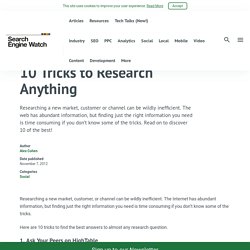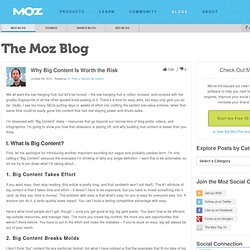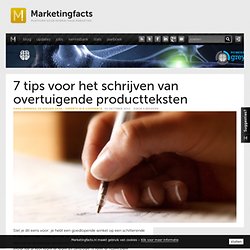

10 Tricks to Research Anything. Researching a new market, customer, or channel can be wildly inefficient.

The Internet has abundant information, but finding just the right information you need is time consuming if you don’t know some of the tricks. Here are 10 tricks to find the best answers to almost any research question. 1. Ask Your Peers on HighTable Getting trusted recommendations from your network is always the best option, but sometimes your network isn’t big enough or experienced enough to help.
Enter HighTable. If you’re looking to connect with other people in the startup scene and get expert answers to specific business questions, HighTable can be a useful resource. 2. Google produces and collates a large collection of publicly accessible research through their Think with Google site. Their research library, in particular, is a great place to start any digging depending on what you’re looking for: Facts and Stats are great for presentations. 3.
One of my favorite research tricks is to go to the public library. Content-and-branding-large.jpg 1.200×3.124 pixels. Why Big Content Is Worth the Risk. We all want the low-hanging fruit, but let’s be honest – the low-hanging fruit is rotten, bruised, and covered with the grubby fingerprints of all the other spoiled brats pawing at it.

There’s a time for easy wins, but easy only gets you so far. Sadly, I see too many SEOs putting days or weeks of effort into crafting the perfect low-value scheme, when that same time could’ve easily gone into content that has real staying power and drives sales. I’m obsessed with “Big Content” lately – resources that go beyond our narrow bins of blog posts, videos, and infographics. I’m going to show you how that obsession is paying off, and why building real content is easier than you think. I. First, let me apologize for introducing another important-sounding but vague and probably useless term. 1. If you want easy, then stop reading (this article is pretty long, and that sandwich won’t eat itself).
Here’s what most people don’t get, though – once you get good at big, big gets easier. Marketing Land12 Content Research Tools You Should Be Using. When it comes to content marketing research, there are a lot of tools at your disposal — so many that it can be overwhelming.

From keyword tools and question-and-answer sites to open discussion forums and backlink analyzers, there are tools designed to help you with every step of your content marketing research. But don’t let the sheer number of tools available drive you into analysis paralysis. Remember, this is an idea generation strategy, so try them all, pick a few favorites and make this a part your continuous content research and planning.
Here are twelve you should be using if you aren’t already: 1. All research starts with keywords, so if you haven’t already conducted thorough keyword research for your business, I recommend this as your very first step. This tool can tell you which keywords are searched more than others based on broad, exact or phrase match volumes, depending on your settings. 2. This is a great little site to help quickly generate ideas. 7 tips voor het schrijven van overtuigende productteksten. In een webwinkel kun je (nog) niet face-to-face communiceren en moet je dat overtuigen grotendeels overlaten aan de productdetailpagina.

De productpagina is dus in feite de verkoper die 24/7 beschikbaar is. En omdat de bezoeker op deze pagina slechts 1 klik verwijderd is van zowel weggaan als aankopen, is het essentieel dat de producttekst goed op orde is en inspeelt op de behoefte van de klant. Vanwege dit belangrijke aspect vind je in deze blogpost 7 tips die onmisbaar zijn voor het schrijven van overtuigende productteksten. 1. Verzamel relevante informatie Bij het verzamelen van relevante informatie kun je denken aan 2 soorten informatie. De eerste is feitelijke informatie: wat zijn de eigenschappen en wat zijn de voordelen van het product voor de gebruiker?
De tweede betreft informatie over de doelgroep.